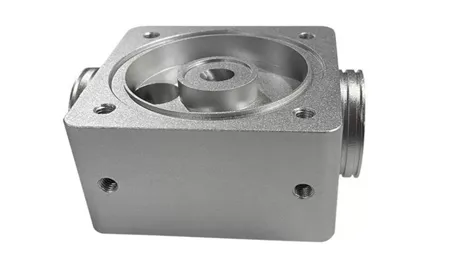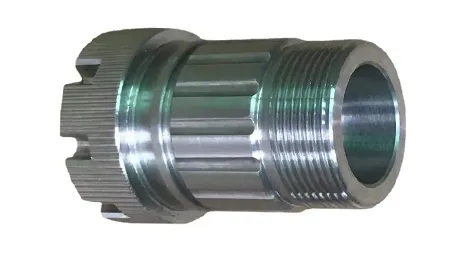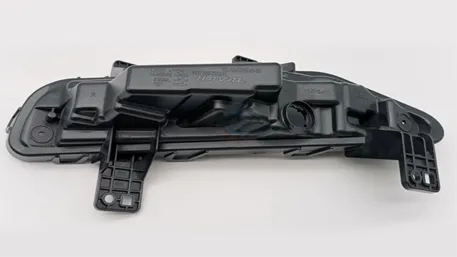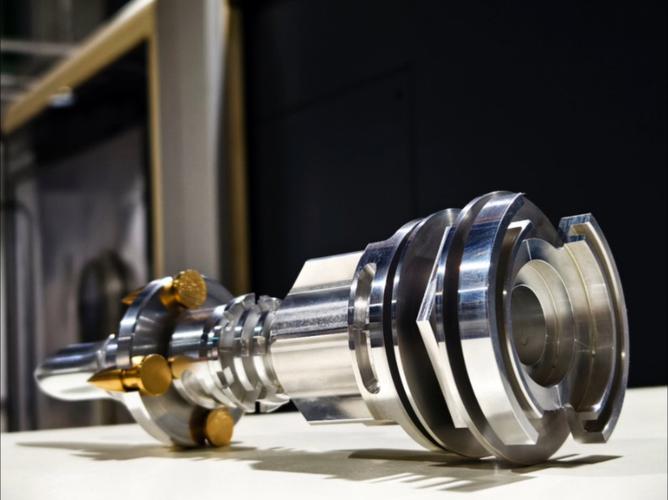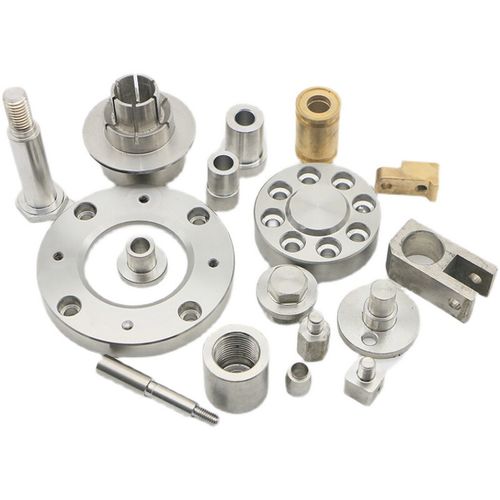5-axis CNC technology, i.e. five-axis CNC machining technology, is an advanced mode of CNC machine tool machining, which adopts linear interpolation motion of any five coordinates in X, Y, Z, A, B and C. This technology combines computer control, high-performance servo drive and precision machining technology to achieve efficient, precise and automated machining of complex surfaces. The following is a detailed introduction to 5-axis CNC technology:
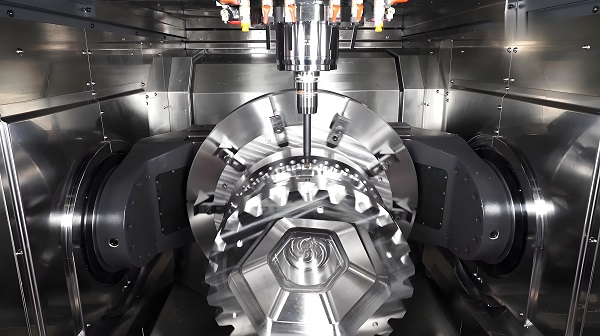
1.Basic Concept
The machine tool used for 5-axis machining is usually called 5-axis machine tool or 5-axis machining center. A 5-axis machine has at least five axes, including three linear axes (X, Y, Z) and two rotary axes (A, B or C). These axes in the computer numerical control (CNC) system under the control of simultaneous coordinated movement, in order to complete the processing of complex workpieces.
2.Technical features
Strong processing ability: five-axis CNC technology can process the general three-axis CNC machine tools can not be processed or difficult to complete the processing of a clamping continuous, smooth free-form surfaces. For example, blades of aviation engines and turbines, spiral propellers for ships, and shells and molds with special surfaces and complex cavities and holes.
Improvement of machining accuracy and efficiency: As the tool/workpiece attitude angle can be adjusted at any time during machining, 5-axis CNC technology can avoid interference between the tool and the workpiece and complete all machining in one clamping, thus improving machining accuracy and efficiency. In addition, by optimizing the tool/workpiece attitude angle, higher cutting speeds and better surface quality can be achieved.
Flexibility and adaptability: 5-axis CNC technology has a high degree of flexibility and adaptability, able to cope with a variety of complex machining needs. Whether processing large workpieces or small precision parts, five-axis machine tools can provide accurate machining solutions.
3.Machining materials
In the field of machining, especially 5-axis CNC machining, there are many types of machining materials, covering metal, non-metal and composite materials and other categories. The following is a detailed description of these machining materials:
Metal materials
Stainless steel: stainless steel is one of the common metal materials in five-axis machining, with excellent corrosion resistance and good mechanical properties. Stainless steel is widely used in aerospace, automotive, chemical and other fields, especially in the manufacture of components that require high strength and corrosion resistance.
Aluminum Alloy: Aluminum alloy is favored for its low density, high strength and good processing performance. In the aerospace, automotive, and construction industries, aluminum alloys are used to manufacture a variety of structural components and parts to reduce weight and improve overall performance.
Titanium Alloy: Titanium alloy is a high-performance metal material with high strength, low density and good corrosion resistance. Due to its excellent performance, titanium alloys are widely used in aerospace, medical, chemical and other fields. However, titanium alloys are difficult to machine and require specialized 5-axis CNC equipment and techniques.
Copper Alloy: Copper alloy has good electrical conductivity, thermal conductivity and plasticity, so it is widely used in electronics, electrical appliances, construction and other fields. In 5-axis machining, copper alloy can be used to manufacture various precision parts and conductive components.
Cobalt-chromium-tungsten alloy: this alloy has high hardness, high wear resistance and good corrosion resistance, so it is often used in the manufacture of cutting tools, molds and wear-resistant parts.
Carbon steel and alloy steel: such as No. 45 steel, etc., is commonly used in the medium carbon tempered steel, with good comprehensive mechanical properties, widely used in the manufacture of various mechanical parts.
Non-metallic materials
Plastic: Plastic is one of the common non-metallic materials used in 5-axis machining. Polypropylene (PP), polycarbonate (PC), polystyrene (PS) and other plastic materials have good processing performance and a wide range of applications, such as automotive, electronics, home appliances and other industries in the manufacture of parts.
Composite materials: Composite materials are new materials made of two or more materials with different properties compounded by physical or chemical methods. Carbon fiber, glass fiber and other composite materials have the advantages of light weight, high strength, high toughness, etc., and are widely used in aerospace, automotive, sports equipment and other fields. Five-axis CNC machining technology can accurately process these composite materials into a variety of complex shapes of parts.
Wood and stone: Although wood and stone are not traditionally machined materials, five-axis CNC machining technology can also be applied to a certain extent to the processing of these materials. For example, 5-axis CNC engraving machines can produce a variety of exquisite wood products and stone artwork.
Special materials
In addition to the above common metal materials and non-metallic materials, five-axis CNC machining can also handle some special materials, such as ceramics, graphite, cemented carbide and so on. These materials have special physical and chemical properties, which put forward higher requirements for processing equipment and technology.
4.Machining process
In machining, especially when using 5-axis CNC technology for machining, the machining process can be further refined and improved. The following is a detailed addition to the process:
I. Preliminary preparation and planning
Workpiece data modeling:
Use CAD (computer-aided design) software for three-dimensional modeling of the workpiece to ensure that the model accurately reflects the shape, size and characteristics of the workpiece.
According to the design requirements of the workpiece, carry out the necessary process analysis and optimization to determine the best machining strategy and path.
CNC machining program development:
According to the 3D model of the workpiece and the machining requirements, develop a detailed CNC machining program.
Select appropriate tools, fixtures and cutting parameters to ensure the stability and efficiency of the machining process.
Write the CNC machining program, including tool path planning, cutting speed, feed and other parameter settings.
Simulation verification:
Use CAM (Computer Aided Manufacturing) software to simulate and verify the CNC machining program to check whether the tool path is reasonable and whether there are problems such as interference or collision.
According to the simulation results of the machining program to adjust and optimize to ensure the smooth progress of the machining process.
Second, machine tool preparation and debugging
Machine inspection and maintenance:
Conduct a comprehensive inspection of the 5-axis CNC machine tool before machining, including the precision, stability and lubrication system of the machine tool to ensure that the machine tool is in good working condition.
Carry out the necessary maintenance and repair of the machine tool, such as cleaning cutting fluid, coolant and other debris, keep the machine clean and dry.
Fixture and tool installation:
Install suitable fixtures and tools according to the requirements of the machining program.
Positioning adjustments are made to the fixtures to ensure the stability and accuracy of the workpiece in the machining process.
Carry out the correction of parameters such as length and diameter of the tool to ensure the correct use of the tool.
Parameter setting and debugging:
Set the machining parameters in the machine control system, including cutting speed, feed speed, depth of cut, etc..
Debugging and trial operation of the machine tool to check whether the various functions of the machine tool is normal, to ensure the smooth progress of the machining process.
Third, the machining process monitoring and adjustment
Machining execution:
Start the machine tool, start the implementation of the machining program.
In the machining process, the operator needs to pay close attention to the operating status of the machine tool and the machining situation to ensure that the machining process is carried out smoothly.
Monitoring and adjustment:
Use the monitoring system of the machine tool to monitor the machining process in real time, including cutting force, temperature, vibration and other parameters.
If it is found that the machining quality does not meet the requirements or the machine tool is running abnormally, it is necessary to stop the machine in time to check and adjust.
According to the machining situation on the cutting parameters for dynamic adjustment to optimize the machining effect and improve machining efficiency.
Fourth, the completion of processing and subsequent processing
Workpiece inspection:
After machining is completed, use measuring tools to inspect the workpiece, including size, shape, surface roughness and other parameters of the measurement.
Ensure that the processing quality of the workpiece meets the design requirements, if necessary for repair or re-processing.
Machine Tool Cleaning and Maintenance:
Clean and maintain machine tools, removing cutting fluids, coolants, and other debris to keep them clean and dry.
Conduct regular inspection and maintenance of machine tools to ensure long-term stable operation.
Workpiece delivery and record:
Packaging and labeling of the inspected and qualified workpieces, and then delivering them to the customers or into the next process for subsequent processing.
Record the key parameters and precautions in the machining process to provide reference and reference for the subsequent machining.
5.Application Fields
5-axis CNC technology is widely used in many fields due to its high precision and high efficiency machining capability:
Aerospace
Key parts processing: In the aerospace field, 5-axis CNC technology is widely used in processing various key parts, such as turbine blades, combustion chambers, nozzles and other parts of aircraft engines. These parts have complex curved surfaces and high precision requirements that are difficult to meet with traditional machining methods, but 5-axis CNC technology is able to cope with them easily.
Improved safety and performance: Through precise machining, 5-axis CNC ensures the quality and performance of these critical components, thus improving the safety and performance of the entire aircraft.
Automotive manufacturing
Engine and transmission manufacturing: In automotive manufacturing, 5-axis CNC technology is used to machine complex parts such as engine blocks, cylinder heads, crankshafts and connecting rods, as well as key components such as transmission housings and gears. The machining accuracy and surface quality of these components directly affect the performance and life of the vehicle.
Improve production efficiency and reduce costs: 5-axis CNC technology can realize multi-surface simultaneous machining and automatic tool change, which greatly improves production efficiency and reduces production costs.
Mold Manufacturing
Complex Surface Mold Processing: Mold manufacturing is one of the important application areas of 5-axis CNC technology. Traditional mold processing methods are often difficult to deal with complex surfaces, while 5-axis CNC technology can easily process a variety of complex surfaces of the mold to meet the mold manufacturing industry’s high-precision and high-efficiency requirements.
Improvement of mold quality and production efficiency: 5-axis CNC machining of molds not only improves the machining accuracy and surface quality of molds, but also reduces the number of fixtures and tooling costs, and improves production efficiency.
Medical Equipment
Complex medical device parts processing: In the field of medical devices, 5-axis CNC technology is used to process various complex shapes of medical device parts, such as artificial joints, heart valves and so on. These parts require the highest levels of precision and surface quality, which 5-axis CNC technology is able to meet.
Enhance the performance of medical devices: Precise machining ensures the performance and safety of medical devices, providing better treatment results for patients.
Other areas
Chemical equipment: 5-axis CNC technology can also be used to process a variety of complex chemical equipment, vessels and pipelines, and other products, to meet the high precision, high quality and corrosion resistance requirements of chemical equipment.
Shipbuilding, textile, food processing, etc.: In addition, 5-axis CNC technology is also widely used in shipbuilding, textile, food processing and many other industries, providing important technical support for the development of these industries.
5-axis CNC FAQ
What are the advantages of 5-axis CNC machine tools over traditional 3-axis machines?
A: 5-axis CNC machine tools have the following advantages over traditional 3-axis machines:
Multi-directional machining capability: 5-axis machine tools can process in multiple directions, realizing direct machining of complex surfaces and reducing the use of processes and fixtures.
Improved machining accuracy: By completing the machining of multiple surfaces in a single clamping, the error caused by datum conversion is reduced, and the machining accuracy is improved.
Improvement of machining efficiency: 5-axis machine tools can complete multiple processes in one clamping, reducing the number of clamping times and workpiece movement time, thus improving machining efficiency.
Reduced labor cost: The high degree of automation reduces manual intervention and lowers labor cost.
Material saving: due to high machining precision, material waste is reduced.
What are the main structural forms of 5-axis CNC machine tools?
A: The main structural forms of 5-axis CNC machine tools include:
Double pendulum head form: two rotation coordinates directly control the direction of the tool axis.
Pendulous pendulum head form: two coordinate axes are at the top of the tool, but the rotation axis is not perpendicular to the linear axis.
Double rotary table form: two rotating coordinates directly control the rotation in space, and two coordinate axes are on the table.
Pendulum table form: two coordinate axes are on the table, but the rotation axis is not perpendicular to the linear axis.
One pendulum and one rotation form: one of the two rotating coordinates acts on the tool and the other on the workpiece.
How difficult is it to program a 5-axis CNC machine?
Answer: 5-axis CNC machine tools are relatively difficult to program because of the need to handle multiple axes of motion and coordination. Programmers need to have advanced programming skills to perform complex spatial geometry operations to ensure coordination of the axes’ movements and avoid collisions. In addition, CAM programming and post-processing for 5-axis machines is more complex than for conventional 3-axis machines.
What are the initial and maintenance costs of a 5-axis CNC machine?
Answer: The initial cost of a 5-axis CNC machine is typically much higher than that of a traditional 3-axis machine, primarily due to its more complex mechanical structure and more advanced CNC system. The maintenance requirements of the machine are also more challenging and maintenance costs are correspondingly higher. However, in the long run, the high efficiency, high precision and low labor costs of 5-axis machines can bring significant economic benefits to businesses.
How to choose the right 5-axis CNC machine?
Answer: Choosing the right 5-axis CNC machine needs to consider the following factors:
Processing demand: choose the right machine model and configuration according to the shape, size and machining accuracy requirements of the workpiece.
Productivity: Consider whether the machining speed and efficiency of the machine meet the production demand.
Cost-effectiveness: Evaluate the initial cost, maintenance cost and long-term economic benefits of the machine tool.
Technical support and service: Choose a supplier with good technical support and after-sales service.

